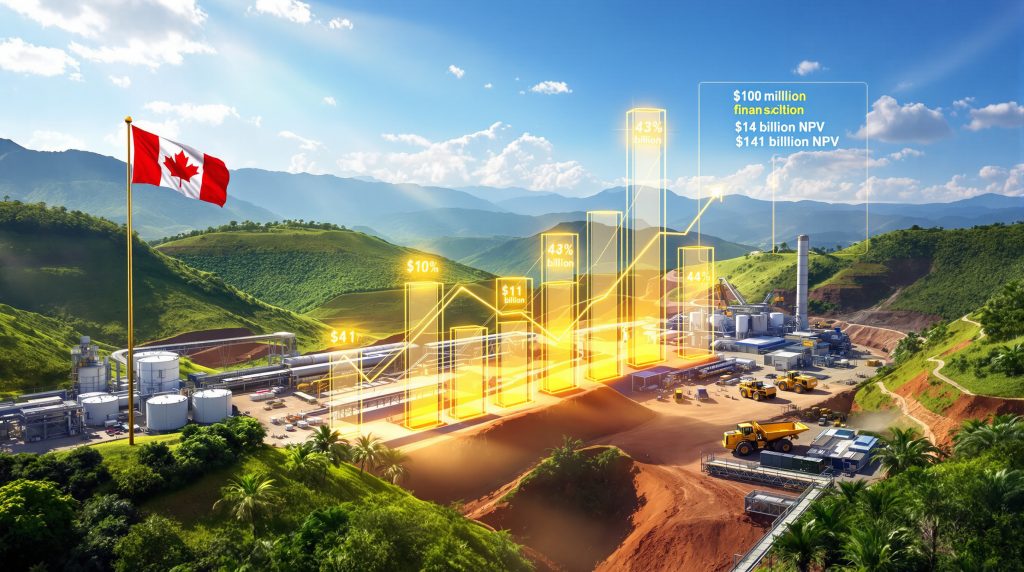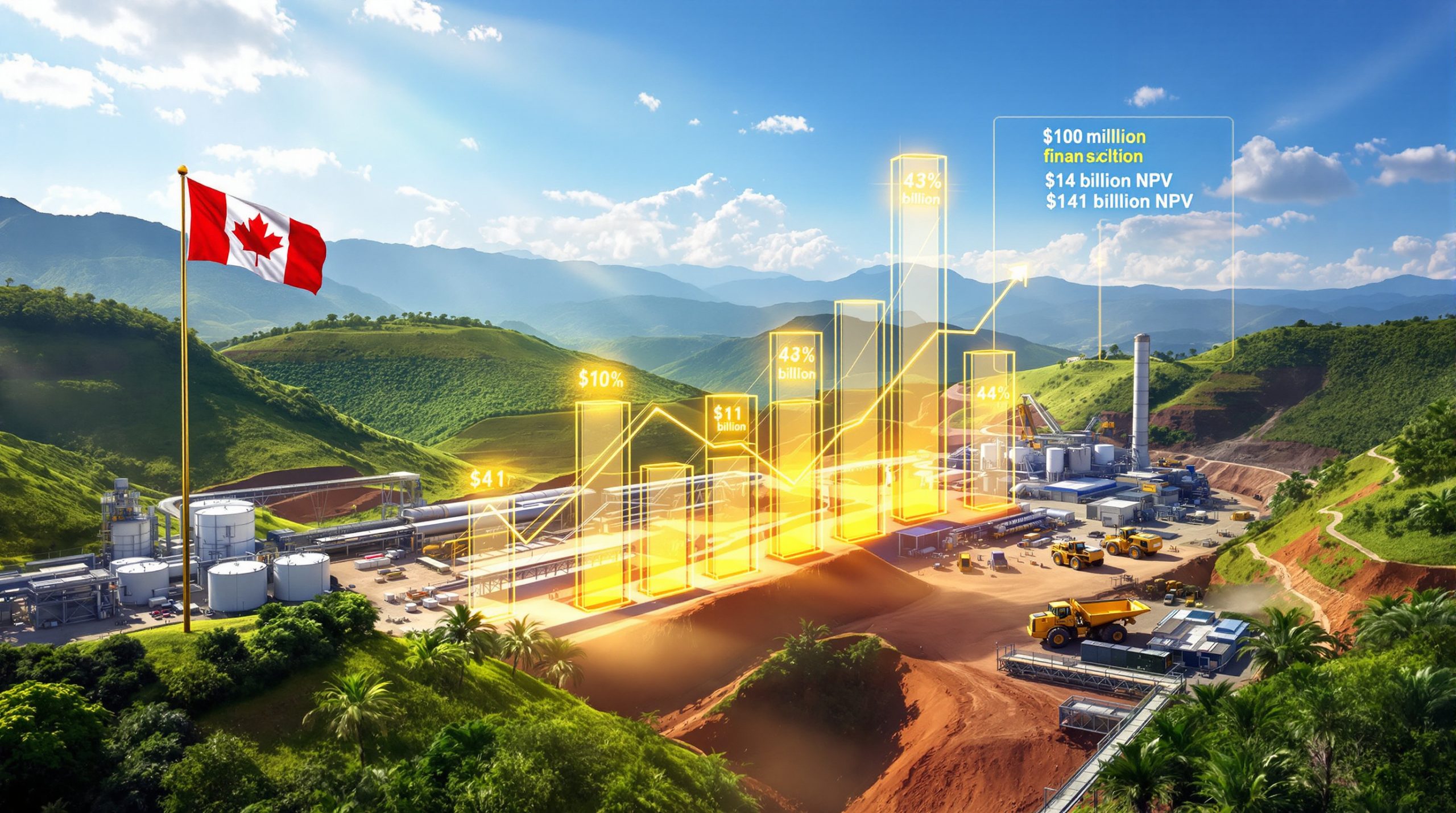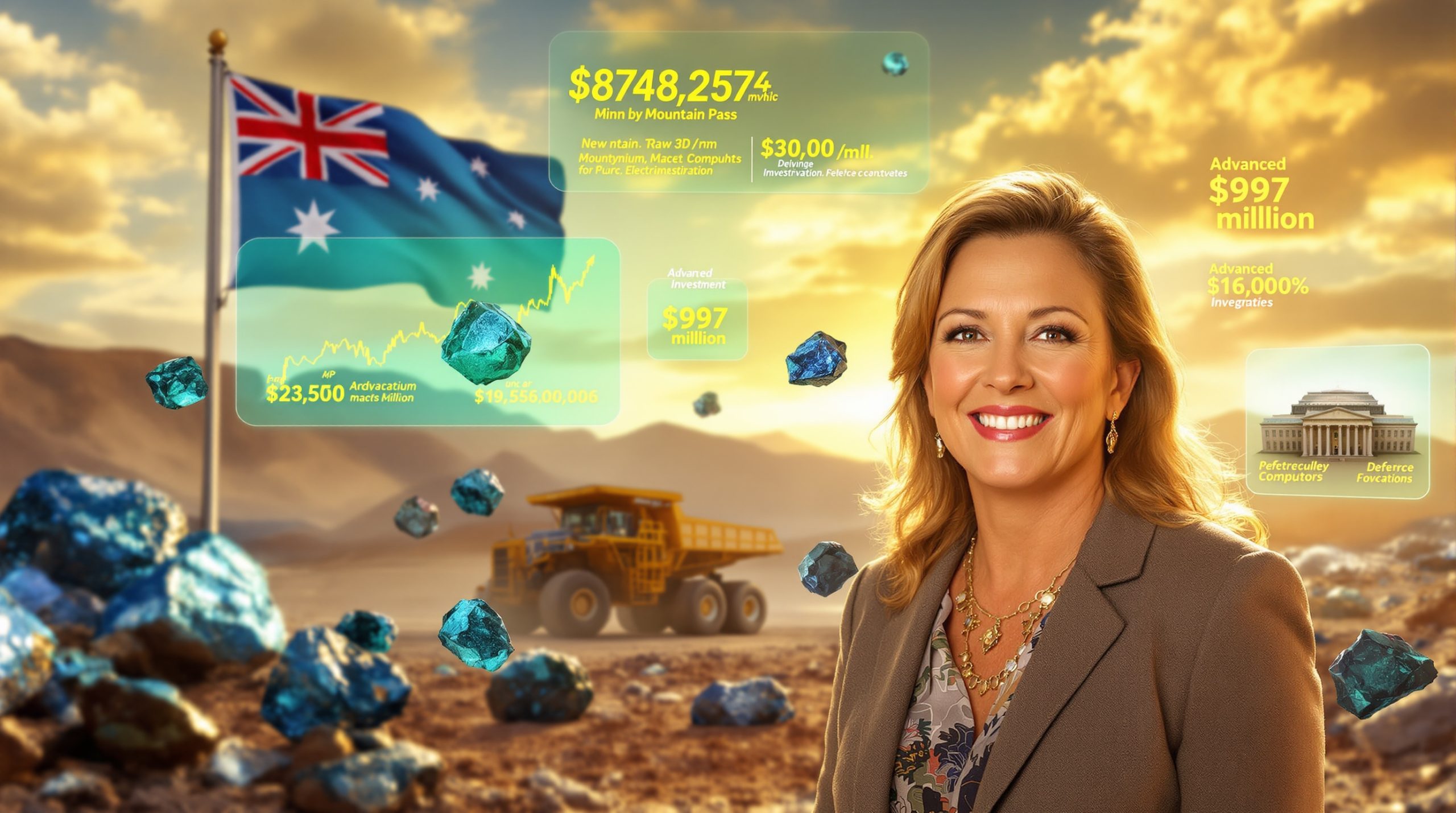EDC's Strategic Financing Framework for International Mining Projects
Export Development Canada operates as the nation's official export credit agency, providing essential financial infrastructure for Canadian companies pursuing international opportunities and foreign projects that deliver strategic benefits to Canada. The organization functions as a Crown corporation, offering sophisticated financing instruments specifically designed for large-scale industrial developments requiring substantial capital commitments over extended timeframes.
Furthermore, EDC's financing approach targets projects where traditional commercial banking faces limitations due to political risk, extended development periods, or complex cross-border regulatory requirements. This positioning makes the agency particularly relevant for critical minerals strategy projects, where supply chain security considerations align with commercial financing needs.
The agency's risk assessment methodology incorporates comprehensive due diligence across multiple dimensions. Political risk evaluation examines country-specific factors including regulatory stability, currency convertibility, and sovereign creditworthiness. However, technical feasibility analysis reviews engineering studies, resource quality assessments, and operational complexity factors.
Financing Structures and Risk Mitigation Tools
Export credit agencies internationally utilise similar structural approaches for mining project finance, reflecting industry-standard practices developed through decades of cross-border resource development. These mechanisms typically feature extended repayment periods matching infrastructure project timelines, with pricing that incorporates both sovereign risk premiums and project-specific factors.
Currency hedging represents a critical component of international project financing, particularly for developments spanning multiple jurisdictions. In addition, standard hedging mechanisms include back-to-back loan structures denominated in the borrowing currency, currency swap arrangements, and fixed exchange rate protections for foreign currency exposure periods.
Consequently, risk premium calculations follow established methodologies that layer sovereign risk assessments with project-specific technical evaluations. These frameworks incorporate country credit ratings, commodity price volatility analysis, and political stability indicators to determine appropriate lending terms and conditions.
Viridis Canadian Financing for Rare Earths Project: Technical and Economic Foundations
The Colossus rare earth development in Brazil represents a significant ionic clay deposit that has attracted international financing interest through its combination of technical characteristics and strategic positioning. Ionic clay rare earth deposits offer distinct advantages over traditional hard rock mining operations, including reduced capital requirements, simplified processing methodologies, and accelerated development timelines.
Industry analysis confirms ionic clay deposits typically require 30-40% less initial capital expenditure compared to hard rock operations. This cost advantage stems from simplified extraction techniques utilising heap leaching and in-situ recovery methods rather than complex crushing and grinding operations required for carbonatite or other hard rock deposit types.
Processing Technology and Operational Advantages
Ionic clay rare earth extraction utilises established hydrometallurgical processes that have demonstrated commercial viability across multiple global operations. Moreover, the technology involves in-situ leaching with dilute acid or alkaline solutions, followed by solvent extraction for individual element separation.
Key technical considerations for ionic clay processing include:
• Clay composition variability within the deposit boundaries
• Moisture content optimisation for leaching efficiency
• Solution chemistry management for maximum element recovery
• Element recovery rates typically ranging from 70-90% depending on specific rare earth elements
This processing approach significantly reduces environmental impact compared to hard rock mining, as it eliminates the need for extensive crushing, grinding, and tailings management systems. For instance, the reduced processing complexity also translates to lower ongoing operational costs and simplified workforce requirements.
Economic Modelling and Financial Projections
Rare earth project economics depend heavily on deposit grade, element distribution, and processing efficiency factors. Furthermore, ionic clay deposits typically contain higher proportions of heavy rare earth elements, which command premium pricing in global markets due to their critical applications in permanent magnets and advanced technology sectors.
Development timelines for ionic clay projects average 4-6 years from feasibility completion to commercial production, compared to 8-12 years typically required for hard rock rare earth operations. This accelerated timeline reduces financing risk exposure and provides earlier cash flow generation for debt service obligations.
Strategic Rationale Behind Viridis Canadian Financing for Rare Earths Project
Canada's Critical Minerals Strategy, released in 2023, specifically identifies rare earth elements as strategic priorities for supply chain diversification and national security considerations. The policy framework recognises Canada's position as the world's fourth-largest rare earth element consumer while importing approximately 90% of requirements from Chinese sources.
Geopolitical Risk Mitigation Through Supply Diversification
The global rare earth supply chain presents documented vulnerabilities concentrated in single-jurisdiction processing capacity. However, the current focus on tariffs impact markets demonstrates how geopolitical tensions affect commodity flows. China controls approximately 70-80% of global rare earth processing infrastructure, creating potential supply disruption risks for Western manufacturing sectors.
Recent export restrictions on rare earth materials have highlighted Western supply chain vulnerabilities, driving policy initiatives across North America and Europe to develop alternative supply sources. Consequently, Brazilian rare earth projects offer strategic advantages through:
• Geographic proximity to North American consumption markets
• Established political and economic relationships with Western nations
• Stable regulatory environment with 70+ years of international mining experience
• Existing infrastructure supporting large-scale mining operations
Brazil's Mining Sector Credibility and Investment Framework
Brazil ranks among the world's top five mineral-producing nations, maintaining the second-largest iron ore production capacity globally and seventh-largest gold production. This established mining industry trends provide confidence for international financiers through proven operational expertise, developed supply chain infrastructure, and mature regulatory frameworks.
The country's investment grade sovereign credit rating (BBB- from Standard & Poor's) supports favourable financing terms for project development. Furthermore, Brazil's Constitution Article 5 provides explicit property rights protections for foreign investors, while bilateral investment treaty provisions with Canada create additional legal safeguards.
"Brazil's mining regulatory structure reflects seven decades of international mining sector participation, providing established legal frameworks and operational precedents that reduce regulatory risk for new project development."
Comparative Analysis of Global Rare Earth Project Financing
International rare earth project financing has evolved significantly over the past decade as governments recognise supply chain vulnerabilities and implement strategic mineral policies. In addition, export credit agencies have become increasingly active in financing critical mineral projects that align with national security objectives.
Financing Scale and Structure Comparisons
Recent rare earth project financing demonstrates the substantial capital requirements for developing new supply sources outside traditional Chinese production centres. For instance, various capital raising methods are employed to optimise cost of capital while managing risk exposure across different investor categories.
| Project Category | Typical Financing Range | Primary Funding Sources |
|---|---|---|
| Early-stage development | $50-150 million | Export credit agencies, government programmes |
| Mid-tier production | $200-500 million | Syndicated bank facilities, strategic investors |
| Large-scale operations | $1+ billion | Multiple bank consortium, government backing |
The viridis canadian financing for rare earths project fits within the early-stage development category, where export credit agency participation provides crucial validation for additional financing sources. However, the $100 million commitment represents substantial single-source backing that enables project advancement through critical development milestones.
Multi-Source Funding Strategy Benefits
Sophisticated project financing structures combine different funding sources to optimise capital costs while managing investor risk profiles. Export credit agency debt financing typically provides favourable interest rates and extended repayment terms, while equity investors contribute development expertise and market relationships.
The Brazilian project demonstrates this diversified approach through:
• Export Development Canada debt financing commitment
• Brazilian institutional investor equity participation
• Government programme eligibility through BNDES and FINEP initiatives
• Potential strategic investor participation for offtake agreements
This funding diversity reduces dependency on single financing sources while creating multiple pathways for project advancement through different market conditions. Moreover, it demonstrates how US Exim loan strategy concepts are being replicated internationally.
Development Timeline and Regulatory Pathway
Rare earth project development follows structured phases aligned with financing disbursement schedules and regulatory approval requirements. Furthermore, environmental permitting represents the immediate critical path for most Brazilian mining projects, with federal and state agencies requiring comprehensive environmental impact assessments.
Critical Milestone Sequence
Project advancement typically progresses through defined stages that correspond to increasing levels of technical confidence and capital commitment. Early-stage milestones focus on resource definition and regulatory compliance, while later phases emphasise construction and operational readiness.
Phase 1: Regulatory Foundation
• Environmental impact assessment completion
• Federal environmental licensing through IBAMA
• State-level permitting in Minas Gerais
• Community consultation and social licence establishment
Phase 2: Technical Validation
• Demonstration plant construction and commissioning
• Process optimisation and recovery rate confirmation
• Updated mineral resource estimates based on expanded drilling
• Definitive feasibility study completion
Phase 3: Construction and Production
• Final investment decision and financing closure
• Commercial plant construction
• Equipment installation and commissioning
• Production ramp-up and market development
Financing Disbursement Alignment
Export credit agencies structure disbursements against specific project milestones to minimise risk exposure while supporting project advancement. For instance, common conditions include technical study completion, permit acquisition, and construction progress verification through independent engineering assessments.
Typical disbursement schedules allocate initial funding upon final investment decision, with the majority of capital released during construction phases tied to physical completion milestones. Consequently, final disbursements occur upon commercial production achievement and demonstrated operational capability.
Global Supply Chain Impact and Strategic Positioning
The Colossus project's development timeline aligns with increasing global demand for rare earth elements driven by clean energy technology deployment and electric vehicle production expansion. Annual rare earth consumption is projected to increase by 4-6% annually through 2030, with heavy rare earth elements experiencing particularly strong demand growth.
Market Position and Production Significance
New rare earth production capacity outside China represents critical supply chain diversification for Western manufacturing sectors. Furthermore, Brazilian ionic clay deposits offer particular value for heavy rare earth elements essential for permanent magnet applications in wind turbines, electric vehicle motors, and energy storage systems.
Production from the Colossus project would contribute to reduced transportation costs for North American consumers while providing supply security for critical applications. The Western Hemisphere supply corridor created through Canadian financing of Brazilian production reduces geopolitical risks associated with Asian supply chains.
Strategic Mineral Security Benefits
The partnership between Canadian financing institutions and Brazilian resource development creates a powerful model for developing strategic mineral projects outside traditional supply chains. This alignment supports both countries' critical mineral strategies while advancing clean energy transition goals through strategic partnerships and funding.
Supply Chain Advantages:
• Diversification away from single-jurisdiction supply dominance
• Reduced transportation costs and delivery times for North American markets
• Enhanced supply security for defence and clean energy applications
• Potential pricing stability through increased global competition
The development represents a significant step toward establishing resilient critical mineral supply chains that support national security objectives while advancing commercial interests across multiple jurisdictions.
Risk Assessment and Investment Considerations
International rare earth project development involves multiple risk categories that require careful evaluation and mitigation strategies. Technical risks include resource continuity, processing efficiency optimisation, and environmental compliance complexity. However, financial risks encompass currency exchange fluctuations, interest rate variations, and commodity price volatility.
Technical and Operational Risk Factors
Ionic clay rare earth extraction presents specific technical challenges that differ from conventional hard rock mining operations. Clay composition variability across deposit boundaries can affect processing efficiency and recovery rates. In addition, environmental management requires specialised approaches for clay-based extraction systems.
Primary Technical Considerations:
• Resource continuity and grade consistency across mining areas
• Processing technology scalability from demonstration to commercial scale
• Environmental compliance costs for clay-based extraction systems
• Water management and treatment requirements for leaching operations
Financial Risk Mitigation Strategies
Cross-border project financing introduces currency exchange risks, regulatory compliance requirements, and potential changes in bilateral trade relationships. Furthermore, interest rate fluctuations during extended development periods can significantly impact project economics and debt service capabilities.
Risk Mitigation Approaches:
• Currency hedging instruments for foreign exchange exposure
• Fixed-rate financing options to manage interest rate volatility
• Political risk insurance coverage for regulatory or policy changes
• Diversified revenue streams across multiple rare earth elements
Consequently, export credit agency participation provides additional risk mitigation through government backing and established international arbitration mechanisms for dispute resolution.
The viridis canadian financing for rare earths project represents a significant development in international critical mineral supply chain diversification, combining Canadian financing expertise with Brazilian resource endowments to create resilient alternatives to traditional supply sources. This partnership model demonstrates the potential for strategic mineral development outside established supply chains while advancing both countries' economic and security interests.
Ready to Capitalise on Critical Mineral Discoveries?
Discovery Alert's proprietary Discovery IQ model delivers real-time alerts on significant mineral discoveries across critical commodities, instantly empowering subscribers to identify actionable opportunities ahead of the broader market. Understand why major mineral discoveries can lead to substantial market returns by exploring Discovery Alert's dedicated discoveries page, showcasing historic examples of exceptional outcomes, and begin your 30-day free trial today to position yourself ahead of the market.




